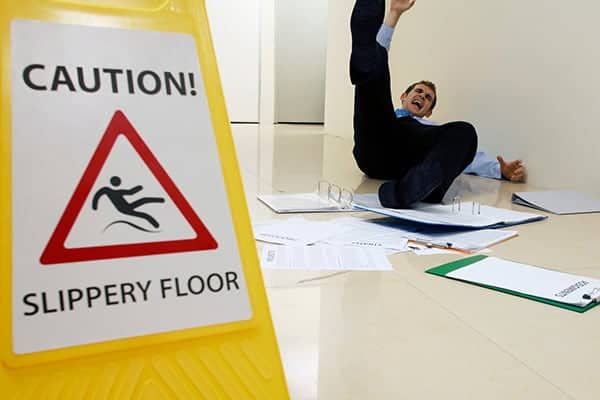
Accident books: what they are and when you need one
Posted on 12th May 2022 by Katherine Ducie

Accidents can happen in almost any job, from the safest of desk-based roles to construction and engineering jobs. No matter what industry your company is in, the law requires that most employers keep track of incidents that occur at work, and this is known as RIDDOR (Reporting of Injuries, Diseases and Dangerous Occurrences Regulations).
What is an accident report book?
An accident book is a place where incidents and accidents in the workplace can be recorded. It documents the type of incident that occurred, the person/people involved, the date, time and location of the incident, and more. Recording such information can bring recurring accidents to your attention, so you can implement additional health and safety measures, and it can also cover you should a claim be made by an employee or contractor.
When is an accident book required in the workplace?
Your business will need an accident book if you employ more than 10 members of staff, or you own or occupy a factory, mine or quarry. If you meet the criteria, it is a requirement to keep an accident book on site under social security law.
The regulations may be slightly different if you’re a freelancer, so use our guide to find out how to report an accident when you’re self-employed.
When does an accident book need to be filled out?
As well as knowing whether you need an accident book or not, it’s important to understand when it needs to be filled out. There are certain types of injuries and diseases that absolutely must be reported.
It’s important to note that ‘reporting’ and ‘recording’ are slightly different. A report involves telling the relevant enforcing authority about the incident, whereas a record is for the business’ use.
Specific injuries that occur in the workplace that must be reported include:
- Fractures (except to fingers, thumbs and toes)
- Loss of consciousness caused by a head injury or suffocation
- Amputations
- Any injury from working in an enclosed space that:
- leads to hypothermia or illness caused by heat
- results in resuscitation or admittance to hospital (more than 24 hours admittance)
- Any injury that leads to permanent loss or reduction of sight
- Burns that cover more than 10% of the body
- Burns that cause significant damage to the eyes, respiratory system or vital organs
- Crush injuries to the head or torso that result in damage to the brain or internal organs
When an employee is required to take seven days off work because they are unable to perform their work duties due to an injury, the accident must be reported, even if the injury isn’t listed above. The seven days doesn’t include the day of the accident, and the report must be documented within 15 days.
Where an employee cannot work for three days following an injury, the accident must be recorded, but not reported. This means that it should be recorded in an accident book, but doesn’t need to be documented anywhere else.
Should an injury occur to a member of the public or another person who is not at work but on your premises, the accident should be reported if they are taken straight to a hospital to treat their injury.
It isn’t just injuries that should be reported, either, but certain occupational diseases that have been caused or made worse by the employee’s work. These can include:
- Severe cramps of the hand or forearm
- Carpal tunnel syndrome
- Hand-arm vibration syndrome
- Occupational dermatitis
- Occupational asthma
- Tendonitis of the hand or arm
With the exception of suicide, the deaths of workers and non-workers must be reported if they were caused by a work-related incident.
What information should the accident book include?
When filling out an accident book, it’s important that the proper information is included, and there is some data that absolutely must be reported.
- Personal information
The first information to be included is personal data. This could include the injured person’s name, date of birth, occupation, telephone number, email address, home address and their relationship to the company (customer, employee, contractor, member of the public and so on).
- Information of the witness
This isn’t the witness of the incident, but the person witnessing the accident book being filled out. It should include name, position and phone number as a minimum.
- Incident details
Next is the most important part – the details of the incident itself. Start with the date, time and location. Then, describe the type of injury that has occurred in the workplace. You should try to be as specific as possible here – where has the person been injured, what type of injury do they have and what does the injured area look like (bruised, burned, red, swollen etc.)?
If the injury can’t be seen, try to explain the pain they’re in or other physical symptoms. For instance, some injuries such as fractures can’t be seen without an X-Ray, but the person might not be able to move their fingers or they might have heard a crack.
You should make a note of whether the person has gone or will go to hospital and how they got there.
- Witness details
Most incidents that occur in the workplace will have been witnessed by another person. You should ask if anyone was present when the accident occurred, and take a note of their name, contact number, email address and home address.
- What happened
So far, you’ve described the injuries that the person sustained, but this section requires you to explain how it happened. You can ask the injured person what they were doing when the accident happened, whether it’s a task they’ve done before, whether it was a work task, what went wrong, what protective equipment they were wearing, etc.
- Employee background
Though you don’t want to point blame, there are some questions that should be considered about the employee. Answering such questions could highlight where further training is needed, or where certain tasks should be left to more senior members of staff.
Make a note of whether the injured person is a new member of the business, how much training they’ve had, their physical and mental state, etc.
- The aftermath
The accident book should show what happened after the incident, to demonstrate how it was handled and what the outcome was. You should include information around any procedures that took place, first aid that was administered, whether an ambulance was called and any other useful information.
Who can fill out an accident book?
While the person involved in the incident can fill the book out themselves, it’s usually best that they are assisted by another employee, usually a member of HR. The accident book should be kept confidential, and in a safe, secure place so other employees can’t access it.



